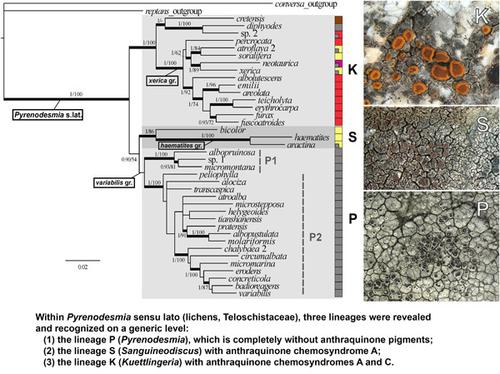当前位置:
X-MOL 学术
›
J. Syst. Evol.
›
论文详情
Our official English website, www.x-mol.net, welcomes your
feedback! (Note: you will need to create a separate account there.)
Phylogenetic relationships within Pyrenodesmia sensu lato and the role of pigments in its taxonomic interpretation
Journal of Systematics and Evolution ( IF 3.4 ) Pub Date : 2020-12-18 , DOI: 10.1111/jse.12717 Ivan Frolov 1 , Jan Vondrák 2, 3 , Jiří Košnar 3 , Ulf Arup 4
Journal of Systematics and Evolution ( IF 3.4 ) Pub Date : 2020-12-18 , DOI: 10.1111/jse.12717 Ivan Frolov 1 , Jan Vondrák 2, 3 , Jiří Košnar 3 , Ulf Arup 4
Affiliation

|
Most lichens of the family Teloschistaceae (Ascomycota) produce yellow-orange-red anthraquinone pigments. However, the genus Pyrenodesmia encompasses species in which anthraquinones are absent and replaced by a gray pigment Sedifolia-gray. It was shown recently that these species are related to taxa with both anthraquinones and Sedifolia-gray (Caloplaca xerica group, C. haematites group, and C. cretensis) and to species with a brown pigment instead of both anthraquinones and Sedifolia-gray (C. demissa, C. obscurella, and C. reptans). Nevertheless, relationships between mentioned anthraquinone-containing and anthraquinone-lacking species remained unclear. In total, 8 DNA loci from 41 species were used here to resolve these uncertainties. We concluded that C. demissa, C. obscurella, and C. reptans are rather distant from the core of Pyrenodesmia, and we place them outside of Pyrenodesmia sensu lato. Within Pyrenodesmia sensu lato, three lineages were revealed and recognized on a generic level: the genus Pyrenodesmia sensu stricto (21 species), the genus Kuettlingeria (14 species), which is resurrected here, and the genus Sanguineodiscus (4 species), which is newly described here. The genus Pyrenodesmia includes taxa that never contain anthraquinones, but Sedifolia-gray. It matches with the former C. variabilis group. Taxa of the genera Kuettlingeria and Sanguineodiscus have anthraquinones in their apothecia and Sedifolia-gray in their thalli. The genus Kuettlingeria includes the former C. xerica group plus C. cretensis and C. diphyodes. The genus Sanguineodiscus includes the former C. haematites group and C. bicolor. The identity of Kuettlingeria (Caloplaca) diphyodes was clarified and the name Pyrenodesmia helygeoides was resurrected. Twenty-four new combinations were proposed.
中文翻译:

Pyrenodesmia sensu lato 的系统发育关系和色素在其分类学解释中的作用
大多数 Teloschistaceae (Ascomycota) 的地衣产生黄橙红色蒽醌色素。然而,Pyrenodesmia属包括没有蒽醌并被灰色色素 Sedifolia-gray 取代的物种。它最近被显示,这些物种相关的与两个蒽醌和Sedifolia灰色类群(橙衣属xerica基,C.赤铁矿组,和Ç。cretensis)和物种用棕色颜料,而不是两个蒽醌和Sedifolia灰色(Ç . demissa、C.obblella和C. reptans)。然而,所提到的含蒽醌和不含蒽醌的物种之间的关系仍不清楚。这里总共使用了来自 41 个物种的 8 个 DNA 位点来解决这些不确定性。我们得出的结论是C. demissa,C. obscurella和C. reptans是从核心相当远Pyrenodesmia,我们外面把他们Pyrenodesmia意义上拉托。在Pyrenodesmia sensu lato 中,在通用水平上揭示并识别了三个谱系:Pyrenodesmia sensu stricto属(21 种)、在这里复活的Kuettlingeria属(14 种)和Sanguineodiscus属(4种),这是新描述的here。Pyrenodesmia属包括从不含有蒽醌的分类群,但是 Sedifolia 是灰色的。它与以前的C. variabilis组相匹配。Kuettlingeria和Sanguineodiscus属的分类群在它们的 apothecia 和 Sedifolia-gray 的菌体中含有蒽醌。Kuettlingeria属包括以前的C. xerica组加上C. cretensis和C. diphyodes。Sanguineodiscus属包括以前的C. 赤铁矿组和C. bicolor。Kuettlingeria的身份(Caloplaca ) diphyodes被澄清,Pyrenodesmia helygeoides的名字被复活了。提出了二十四种新组合。
更新日期:2020-12-18
中文翻译:

Pyrenodesmia sensu lato 的系统发育关系和色素在其分类学解释中的作用
大多数 Teloschistaceae (Ascomycota) 的地衣产生黄橙红色蒽醌色素。然而,Pyrenodesmia属包括没有蒽醌并被灰色色素 Sedifolia-gray 取代的物种。它最近被显示,这些物种相关的与两个蒽醌和Sedifolia灰色类群(橙衣属xerica基,C.赤铁矿组,和Ç。cretensis)和物种用棕色颜料,而不是两个蒽醌和Sedifolia灰色(Ç . demissa、C.obblella和C. reptans)。然而,所提到的含蒽醌和不含蒽醌的物种之间的关系仍不清楚。这里总共使用了来自 41 个物种的 8 个 DNA 位点来解决这些不确定性。我们得出的结论是C. demissa,C. obscurella和C. reptans是从核心相当远Pyrenodesmia,我们外面把他们Pyrenodesmia意义上拉托。在Pyrenodesmia sensu lato 中,在通用水平上揭示并识别了三个谱系:Pyrenodesmia sensu stricto属(21 种)、在这里复活的Kuettlingeria属(14 种)和Sanguineodiscus属(4种),这是新描述的here。Pyrenodesmia属包括从不含有蒽醌的分类群,但是 Sedifolia 是灰色的。它与以前的C. variabilis组相匹配。Kuettlingeria和Sanguineodiscus属的分类群在它们的 apothecia 和 Sedifolia-gray 的菌体中含有蒽醌。Kuettlingeria属包括以前的C. xerica组加上C. cretensis和C. diphyodes。Sanguineodiscus属包括以前的C. 赤铁矿组和C. bicolor。Kuettlingeria的身份(Caloplaca ) diphyodes被澄清,Pyrenodesmia helygeoides的名字被复活了。提出了二十四种新组合。











































 京公网安备 11010802027423号
京公网安备 11010802027423号